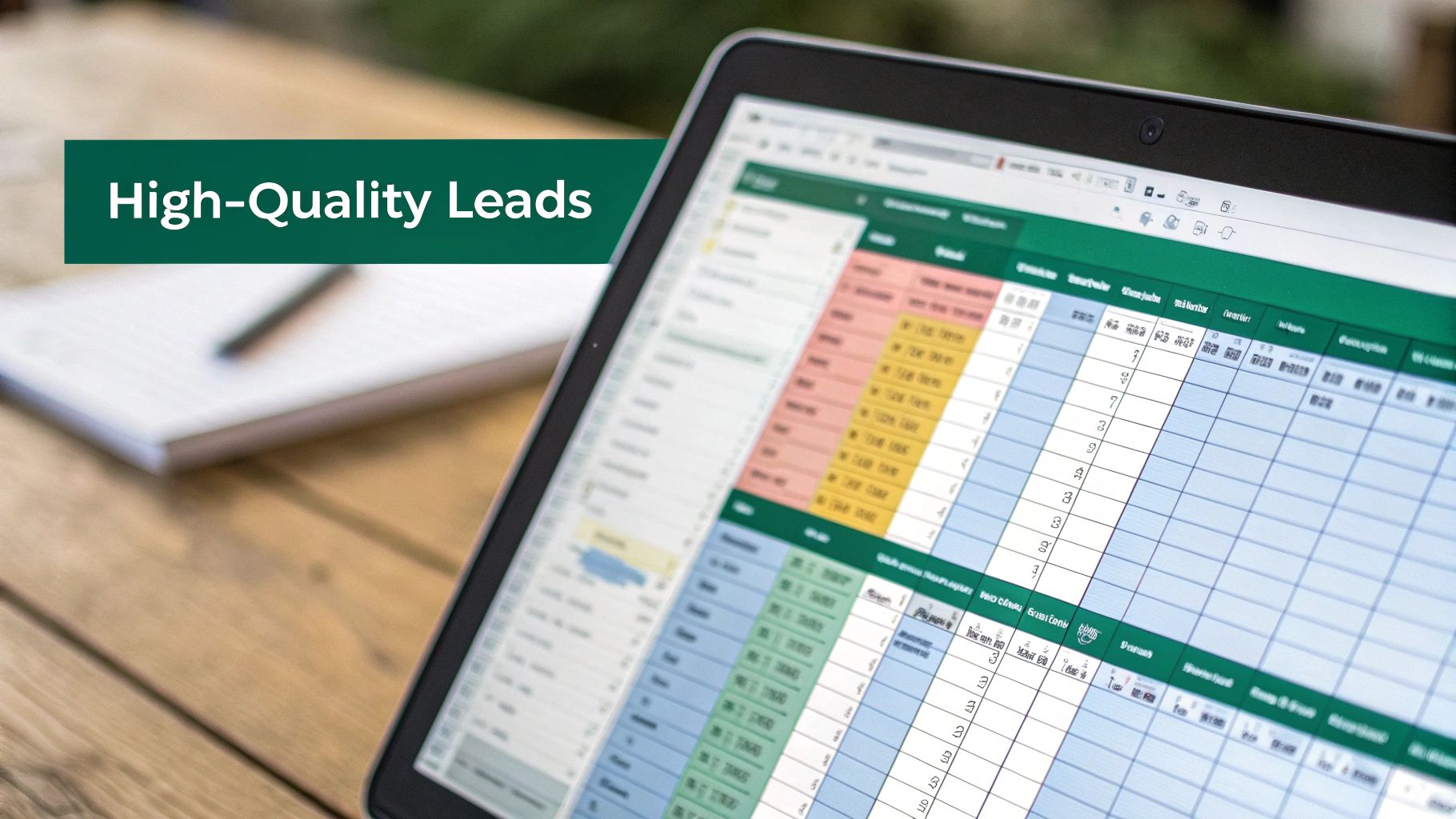In a world drowning in digital noise, making a direct connection is everything. An email extractor from a website isn't just some niche gadget anymore; it’s a must-have for any modern sales, marketing, or recruiting team trying to build those connections without wasting time. It takes the soul-crushing work of manual research and turns it into a real strategic edge.
Why You Need an Email Extractor for Websites

Let's be real: hunting for email addresses one by one is a total time-sink. Picture your sales team, hours deep, clicking through "About Us" pages, staff directories, and ancient blog posts just to scrounge up a handful of contacts. That's not just slow—it's a recipe for mistakes and completely unsustainable if you're trying to grow.
An email extractor just automates the whole thing. It zips through web pages, plucks out publicly available email addresses, and drops them into a clean, ready-to-use list. The whole process takes a fraction of the time. Moving from manual grunt work to smart automation is a complete game-changer.
The Strategic Edge of Automation
By putting email discovery on autopilot, you let your team focus on what they're actually good at: building relationships and closing deals. They can ditch the mind-numbing data entry and spend their time on high-value stuff like writing personalized outreach, running product demos, and actually talking to potential customers.
This switch to automation unlocks some serious benefits:
- Faster Lead Generation: You can build incredibly targeted prospect lists from industry directories, conference speaker pages, or even competitor websites in minutes, not days.
- Sky-High Productivity: Your sales and marketing folks can seriously crank up their outreach volume without watering down the quality of their prospect lists.
- A Real Competitive Advantage: While your competitors are stuck in the manual grind, your team is already connecting with decision-makers and kicking off important conversations.
The real magic of an email extractor isn't just about finding emails. It's about buying back countless hours of lost productivity so your team can stop being data miners and start being relationship builders.
The demand for these tools is exploding for a reason. The global email parsing software market, a big piece of this tech, is on track to hit $2.5 billion in 2025. It’s expected to keep growing at a Compound Annual Growth Rate (CAGR) of 15% all the way through 2033. That kind of growth tells you just how much businesses need to automate their data workflows. If you're curious, you can learn more about these market trends and what they mean for business automation.
Finding Emails Without Automated Tools
Before you jump straight to automation, learning to find emails by hand is a surprisingly powerful skill. It's the perfect play for those high-stakes projects where one accurate contact is worth more than a hundred generic ones. This is all about precision, not just volume.
Think of it as digital detective work. Instead of casting a wide, impersonal net, you're on the ground, carefully following clues to find the exact person you need to reach. Honestly, this manual process gives you a much deeper understanding of your prospect’s organization along the way.
Mastering Google Search Operators
Your first stop is almost always Google, but I'm not talking about a basic search. Advanced search operators, sometimes called "Google dorking," are your secret weapon here. They let you slice through all the internet noise and pinpoint information that’s publicly available but often hidden from a normal search.
The real magic happens when you start combining operators to create laser-focused queries. Let's say you're looking for the marketing director at a company called "Innovate Corp."
You could try a search string like this:
site:innovatecorp.com "marketing director" email
This little command tells Google to search only within the innovatecorp.com website for pages that mention both "marketing director" and "email." It’s a simple but incredibly effective way to uncover contact pages or team bios that might hold the address you're after.
Another great trick is to play the odds and guess common email patterns. Most companies stick to standard formats like firstname.lastname@company.com or firstinitiallastname@company.com. If you know the person's name is Jane Doe, you can search for those specific patterns.
Give this a shot:
site:innovatecorp.com "jane.doe@innovatecorp.com"
Even if that specific email isn't listed outright, this search might just pull up a PDF document or an old press release where it was mentioned, instantly confirming the correct format.
Exploring Company Websites and Social Profiles
Company websites themselves are a goldmine, provided you know where to dig. You have to move beyond the main contact form and explore these often-overlooked pages:
- About Us Pages: These frequently introduce key team members and sometimes, you get lucky with direct contact info.
- Team Directories: Larger companies might have a full staff directory listing names and titles.
- Blog Author Bios: If your target has written for the company blog, their bio at the end of the post is a prime spot for an email address.
- Press Releases or Media Kits: These documents are made for journalists and often include direct contact details for media relations or marketing managers.
The goal is to think like a journalist. Where would the company put contact information for specific, important inquiries? Following that logic often leads you straight to the right person.
Professional social media profiles, especially on platforms like LinkedIn, are also worth a look. While you should never use automated tools to scrape these sites (it’s a big violation of their terms of service), you can absolutely check a person’s public profile manually. Many professionals list their work email right in their contact info to make business connections easier.
For a few more tricks up your sleeve, our guide on how to find an email address from a website breaks down even more manual strategies.
Putting Your Email Extraction on Autopilot
When your lead generation needs to scale, manual searching just can't keep up. The time you spend digging through individual websites is time you aren't spending on outreach or closing deals. This is the moment to shift from manual work to smart automation with an email extractor from websites.
Automated tools do the heavy lifting for you, scanning entire websites or even lists of URLs to pull together contact lists in minutes. We'll use a popular Chrome extension, EmailScout, as our case study to show you just how easy this process can be. It’s a practical way to get from zero to a qualified lead list without getting bogged down in technical details.
Deciding between manual and automated methods often comes down to balancing precision with volume. If you're targeting a handful of high-value prospects, a manual approach makes sense. But for anything bigger, automation is your friend.

As the decision tree shows, manual methods excel when precision is your top priority. For building larger lists quickly, however, automation is the clear winner.
Still on the fence? Here’s a quick comparison to help you decide which email extraction method best suits your immediate needs, based on project scale, speed, and cost.
Manual vs Automated Email Extraction at a Glance
| Factor | Manual Extraction | Automated Extraction (EmailScout) |
|---|---|---|
| Speed | Slow and methodical; minutes per contact. | Extremely fast; hundreds of contacts per minute. |
| Scale | Best for small, highly targeted lists (1-20). | Ideal for large-scale lists (100s or 1000s). |
| Accuracy | High, as each contact is individually verified. | High, but may pull in some generic addresses. |
| Effort | Labor-intensive and requires focused attention. | Minimal effort; runs in the background. |
| Cost | "Free" in terms of money, but costs significant time. | Free and paid plans available to fit any budget. |
Ultimately, both methods have their place. But when you need to build a substantial list without spending days on the task, automation is the only practical choice.
Getting Started with a Chrome Extension
The first step is adding the tool to your browser. Most email extractors, including EmailScout, are found on the Chrome Web Store. A quick search is all it takes.
Once you install it, the extension's icon will pop up in your browser's toolbar. That gives you one-click access to its features whenever you need them. The whole setup takes less than a minute.
The real beauty of a browser extension is how it fits right into your existing workflow. You don't need to juggle different apps or tabs—the tool is always there, right where you're doing your research.
With the tool installed, you're ready to put it to work.
A Practical Extraction Scenario
Let's walk through a real-world example. Imagine you're building a prospect list for a new marketing SaaS product. A great source for leads would be a directory of attendees from a recent industry conference. Manually copying hundreds of names and searching for their emails would take days.
With an automated tool, the workflow is completely different.
- First, navigate to the target page. Just open the conference directory webpage in your Chrome browser. This page might list speakers, sponsors, or registered companies.
- Next, activate the extractor. Click the EmailScout icon in your toolbar. The extension immediately starts scanning the page's code for any email addresses.
- Finally, review and export. Within seconds, the tool shows you a list of all the emails it found. You can quickly review the list, uncheck any irrelevant ones (like
info@orsupport@), and export your clean list as a CSV file.
This simple process transforms a multi-day task into a five-minute job. The speed and efficiency are game-changing, especially when you need to build multiple lists for different campaigns.
And for those times you've already copied a block of text and just need the emails out of it, a free email extractor online is perfect. Just paste your text and it pulls out the contacts instantly.
Fine-Tuning Your Extraction Strategy
While one-click extraction is powerful, the best tools give you more control to get even better results. They come with advanced features to refine your search and ensure you get the highest quality data.
Consider these powerful options:
- Bulk URL Extraction: Instead of visiting pages one by one, you can paste a list of URLs into the tool. It will then crawl all of them for you, compiling a master list of contacts from every site.
- Domain-Level Search: Some extractors can search an entire domain for publicly listed emails, not just the single page you're on. This is perfect for uncovering contacts from various departments within a single company.
- Auto-Save Functionality: You can set the tool to automatically save emails as you browse. As you click through different websites, it quietly collects contacts in the background, building a list without you having to do anything.
By using these features, you move beyond simple page scraping and into a more strategic approach. You can build highly targeted, segmented lists based on specific industries or event attendee lists, setting your outreach campaigns up for much greater success.
Keeping Your Data Clean and Your Outreach Ethical
Pulling a massive list of emails can feel like you've struck gold, but that's really just the first step. A huge list is worthless if it's packed with bad addresses or if you use it the wrong way. The real work starts after you've gathered all that raw data.
This is where data hygiene becomes everything. Think of it as quality control for your entire outreach strategy. If you skip this part, you're basically just shouting into the void and torpedoing your sender reputation with services like Google and Outlook.
The Critical Role of Email Validation
First thing's first: email validation. This is the process of scrubbing your new list to get rid of typos, old addresses, duplicates, and role-based emails like support@ that are dead ends for real conversations.
When you send to invalid addresses, you get a high bounce rate. That's a huge red flag for email providers, who use it to spot spammers. A bounce rate over 2% can get your domain flagged, sending all your future emails straight to the spam folder. Good validation is your best defense.
If you want to get into the nitty-gritty, we have a complete guide that shows you how to validate an email address and keep your sender score safe.
The goal isn't just to send emails; it's to get them delivered and opened. A clean, validated list of 100 engaged contacts is infinitely more valuable than a sloppy list of 1,000 that gets you blacklisted.
Navigating the Ethical and Legal Landscape
Once your list is sparkling clean, you have to think about the ethics and legal rules of outreach. This isn't just about dodging fines—it's about building trust and starting valuable conversations instead of just sending more spam into the world.
You have to be aware of the regulations that govern commercial email. The two big ones are:
- GDPR (General Data Protection Regulation): This one's for EU citizens. It requires a legitimate reason for contacting someone and clear rules around consent.
- CAN-SPAM Act: This is the U.S. law setting the rules for commercial email. It requires an obvious way for people to opt-out and truthful header information.
To make sure your campaigns are on the right side of the law, it's smart to stay up-to-date on the latest email outreach compliance rules. This isn't formal legal advice, of course, but a responsible approach always includes personalizing your message, offering real value, and making your "unsubscribe" link impossible to miss.
Turning Extracted Emails into Real Opportunities

So, you've used an email extractor from websites and now you're sitting on a fresh list of contacts. That's a great start, but it's just that—a start. A raw list of emails is pure potential, but it’s worthless until you plug it into a smart, actionable strategy.
Let's bridge the gap between just having data and actually making money from it.
The real magic happens when you segment that list. Don't just dump everyone into one big bucket. Group your new contacts by industry, their job title, or even the specific website where you found them. Why? Because generic email blasts are a one-way ticket to the spam folder, while targeted messages actually get replies.
Crafting a Compelling First Impression
That first email you send is your one shot to make a real connection. Forget about selling right away. Your only goal should be to offer undeniable value right out of the gate.
Instead of a hard pitch, lead with a genuinely helpful resource, a sharp industry insight you know they'll care about, or a potential solution to a problem you suspect their company is facing.
A first email that actually works usually includes:
- A hyper-personalized opening line: Mention something specific you noticed about their company, a recent project, or their role. Prove you did your homework.
- A clear value proposition: Get straight to the point. How can you help them? Focus on the benefits, not just your product's features.
- A low-friction call-to-action: Don't ask for a sale. Suggest a quick 15-minute call to share an idea, or offer a useful resource with no strings attached.
Your first contact should feel less like a sales pitch and more like the beginning of a helpful conversation. The objective is to build trust by demonstrating you understand their world before you ask for anything in return.
After you've pulled the emails, the next move is figuring out how to generate B2B leads that convert. This knowledge is what turns a simple contact list into a powerful engine for business growth.
Integrating Contacts into Your Workflow
To keep those valuable leads from falling through the cracks, your very next step should be importing the list into your Customer Relationship Management (CRM) system. This is non-negotiable if you want to stay organized and track every interaction.
Once they're in your CRM, you can tag contacts based on your segmentation plan, schedule follow-up tasks so nothing gets missed, and monitor how they're engaging with your outreach. This creates a system. It ensures every single email you extracted gets nurtured properly.
In the end, turning a list of extracted emails into real business relationships is all about a thoughtful, organized, and value-driven approach. You're not just managing data; you're transforming a list of names into a pipeline of genuine opportunities.
When you first start digging into email extractors, a few questions pop up almost immediately. It's totally normal. Getting the right answers upfront helps you build your lists confidently and make sure your outreach is both effective and above board.
Let's clear up some of the most common ones I hear.
The big one is always about legality. Here’s the deal: extracting email addresses that are publicly listed on websites is generally fine. The real question isn't about collecting the data, but how you use it. Any outreach you do has to play by the rules, like the GDPR in Europe and the CAN-SPAM Act in the U.S.
The guiding principle is legitimate interest. You should only be contacting people with a relevant business reason, offering something of clear value, and always giving them a simple, obvious way to opt out. Just remember, this isn't formal legal advice—it’s always smart to check in with a legal pro for your specific situation.
Technical and Practical Concerns
Another common point of confusion is the difference between an email extractor and an email finder. They sound similar, but they do very different jobs.
Think of it like this:
- An Email Extractor is like a net. It scans a webpage and scoops up any email address it can find, like
contact@company.comorinfo@business.net. It’s fantastic for grabbing a bunch of general contacts from a single source. - An Email Finder is more like a sniper rifle. You feed it a person's name and a company, and it hunts for that specific individual's email address, often by testing common patterns.
So, extractors are for casting a wide net on a page, while finders are for zeroing in on a specific person.
What about social media? I get asked all the time if you can pull emails from sites like LinkedIn. The short answer is a hard no. Trying to scrape social media platforms is a direct violation of their terms of service and a surefire way to get your account banned. Stick to company websites, blogs, and public directories where contact info is openly shared.
The key takeaway is this: while tools can automate the grunt work of collecting public data, you are always responsible for using it ethically and legally. Focus on genuine outreach, not spam.
Finally, how do you keep your cold emails from ending up in the spam folder? It all starts with a clean list. Before you send a single message, run your extracted contacts through an email validation tool. This scrubs out the bad addresses that lead to bounces, which can destroy your sender reputation.
From there, it's all about personalizing your outreach, offering real value, and making your unsubscribe link impossible to miss.
Ready to automate your lead generation the right way? EmailScout is the powerful yet easy-to-use email extractor from websites that helps you build targeted marketing lists in a single click. Start finding unlimited emails for free.




